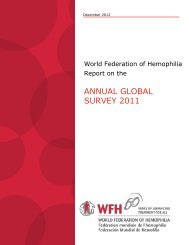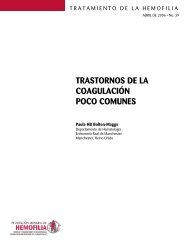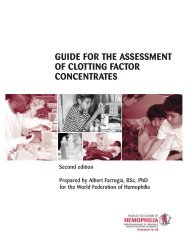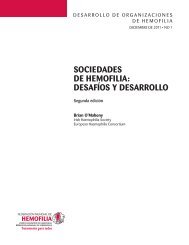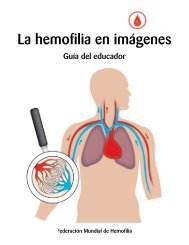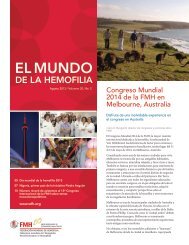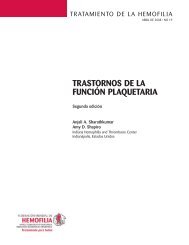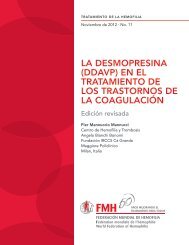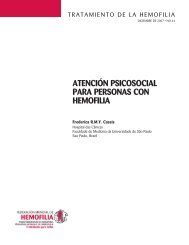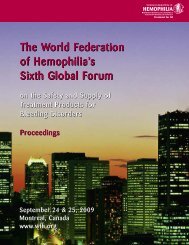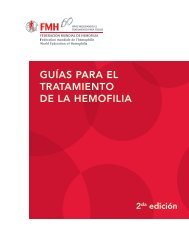musculoskeletal complications of hemophilia: the joint
musculoskeletal complications of hemophilia: the joint
musculoskeletal complications of hemophilia: the joint
Create successful ePaper yourself
Turn your PDF publications into a flip-book with our unique Google optimized e-Paper software.
No <strong>joint</strong> hemorrhage is so minor that treatment may be deferred or postponed, and no plan <strong>of</strong><br />
treatment is complete unless it includes replacement <strong>of</strong> <strong>the</strong> missing clotting factor to a level<br />
sufficiently high to stop <strong>the</strong> bleeding. This level must be maintained long enough to stop <strong>the</strong><br />
bleeding and to prevent recurrence. At <strong>the</strong> present time, episodic replacement <strong>the</strong>rapy is <strong>the</strong><br />
mainstay <strong>of</strong> treatment in <strong>hemophilia</strong>. Most spontaneous hemarthroses respond to a single<br />
infusion <strong>of</strong> factor VIII or factor IX, which achieves a level <strong>of</strong> 30% to 40%. If swelling or<br />
spasm is present, treatment to levels <strong>of</strong> 50% is usually required and <strong>the</strong> infusions may have to<br />
be repeated at 12- to 24-hour intervals. Many patients are on programmes <strong>of</strong> home care.<br />
Follow-up for minor bleeding episodes that respond to a single infusion <strong>of</strong> factor can be left<br />
to <strong>the</strong> discretion <strong>of</strong> <strong>the</strong> educated and motivated person or family with <strong>hemophilia</strong>, but<br />
physician evaluation is required if <strong>the</strong> <strong>joint</strong> <strong>of</strong> bleeding does not respond within 12 to 24<br />
hours.<br />
Minor hemarthroses may not require immobilization, but some individuals find relief from<br />
elastic bandages, foam rubber splints or slings. Some people find that ice helps in <strong>the</strong> relief <strong>of</strong><br />
pain. Severe hemarthroses, in which <strong>the</strong>re is swelling, spasm or infection <strong>of</strong> <strong>the</strong> <strong>joint</strong>, should<br />
be treated with splinting in a position <strong>of</strong> comfort. Prefabricated splints, bulky compression<br />
dressings, or home-made plaster splints can be used. Attempts at correcting <strong>the</strong> deformity<br />
should be deferred until bleeding has been stopped; this will be discussed in <strong>the</strong> next section.<br />
Rest is required for resolution <strong>of</strong> <strong>the</strong> acute symptoms, but, in <strong>the</strong> long run, rest will lead to<br />
limitation <strong>of</strong> motion and muscle atrophy. Therefore, <strong>joint</strong> rehabilitation must be started as<br />
soon as possible, beginning with isometric exercises. As soon as <strong>the</strong> acute symptoms subside,<br />
muscle streng<strong>the</strong>ning and range <strong>of</strong> motion exercises must be started.<br />
Bleeding into <strong>the</strong> <strong>joint</strong> does result in pain. Analgesics may be required to alleviate this and<br />
should be carefully monitored by <strong>the</strong> treating physicians. Any aspirin-containing compound is<br />
contraindicated because <strong>of</strong> <strong>the</strong> risk <strong>of</strong> fur<strong>the</strong>r bleeding due to inhibition <strong>of</strong> platelet function.<br />
Intramuscular injections should be avoided. The use <strong>of</strong> narcotics may be required when <strong>the</strong><br />
pain is severe, but indiscriminate use must be discouraged because <strong>of</strong> <strong>the</strong> chronic nature <strong>of</strong><br />
<strong>the</strong> bleeding and <strong>the</strong> risk <strong>of</strong> addiction. Oral steroids have been shown to decrease <strong>the</strong><br />
inflammatory processes associated with bleeding and are used at many <strong>hemophilia</strong> centers.<br />
Despite <strong>the</strong> well-known <strong>complications</strong>, few problems have been associated with <strong>the</strong>ir use for<br />
three to four days following an acute bleeding episode. Recommended regimens include<br />
Prednisone, 1 to 2 mg/kg/day, for three to four days. Non-steroidal anti-inflammatory<br />
medications (NSAIDS) have not proven very beneficial in decreasing <strong>the</strong> acute inflammatory<br />
reaction and probably should be avoided in acute bleeding episodes because <strong>of</strong> <strong>the</strong>ir<br />
inhibition <strong>of</strong> platelet function and <strong>the</strong> potential to enhance bleeding. Their judicious use,<br />
however, may be helpful in controlling arthritic pain and will be discussed in <strong>the</strong> next section.<br />
Aspiration or removal <strong>of</strong> blood from <strong>the</strong> <strong>joint</strong> with a syringe and needle can be considered.<br />
Theoretically, <strong>the</strong> early removal <strong>of</strong> blood from <strong>the</strong> <strong>joint</strong> should result in a more rapid response<br />
to treatment and should be beneficial in delaying or eliminating <strong>the</strong> development <strong>of</strong> arthritis.<br />
The disadvantages are that <strong>the</strong> patient must ei<strong>the</strong>r come to a physician's <strong>of</strong>fice or to a hospital<br />
3



